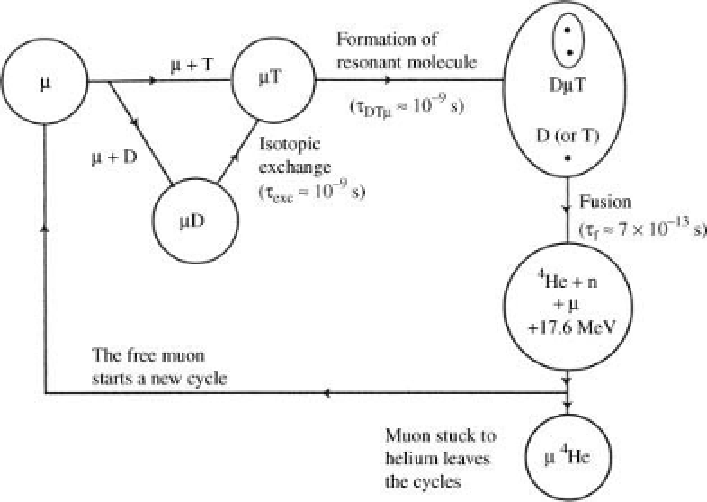Environmental Engineering Reference
In-Depth Information
Table 4.1.) TheGamow factors are almost the same for theDDand theDTcases, sowe
need to learn more about the nuclear reactions.
From the point of view of our calculation, adapting the molecular properties from
the DD case to the DTcase will change in our estimate of
T
f
only slightly. This can be
seen from the larger reduced mass entering the calculation of
c
. For DT, the reduced
mass is
m
r
¼
1.2, a 20% increase, which will increase
c
and reduce
the tunneling rate. The parameter
r
1
, however, is increased from 2.7 f to 2.89 f,
leading again to a small change, but in the opposite sense to that of the effective mass
change. The resulting changes will be small, suggesting that details of the nuclear
tunneling physics, not built into our estimate, may be important.
Why is the D-T
-
T fusion reaction easier to initiate than the D-T
-
D-T reaction?
The difference
is that the DTsystemhas a resonant state at energy 114 keV, as shown in data [50] of
Figure 4.6.
The solid curve in Figure 4.6 is the measured cross section for the D-T
-
T reaction.
Not only is the cross section much larger than the data for the D
-
D reaction (circles)
but it also has a clear peak, at a resonant energy 114 keV. The physical situation is as
described by Figure 2.3, imagining a D coming to collide with a T triton particle,
except that there is a well-de
ned resonant state at positive energy
E
(2
3)/(2
þ
3)
¼
¼
114 keV. This
is ametastable state, which can decay either by back re
ection of the D, or by forming
the
4
He
þ
n
final state. This
final energy is negative (bound and stable), analogous to
the
2.2MeV marked in Figure 2.3 denoting the D ground state.
There are, in effect, two tunnel barriers in this problem. One is the Coulomb
barrier shown in Figure 2.3 and the second effective barrier is between the resonant
Figure 4.6 m-catalysis cycle for the DT gas mixture, as irradiated with mu mesons. Mean reaction
times are indicated for each process [43].

